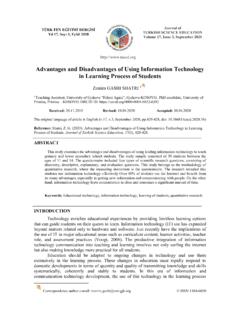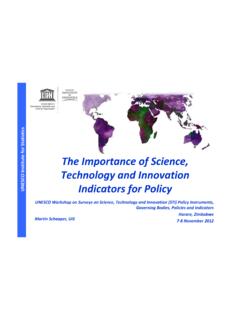Transcription of Measuring the Economic Impact of the Space Sector: Key ...
1 Background paper for the G20 Space Economy Leaders Meeting (Space20)SAUDI ARABIA 7 OCTOBER 2020 Measuring THE Economic Impact OF THE Space SECTORKEY INDICATORS AND OPTIONS TO IMPROVE DATA This document was prepared by the Organisation for Economic Co-operation and Development s Space Forum (the OECD Space Forum) in the Directorate for Science, technology and innovation . It presents a selection of indicators and options for improving the Economic measurement of the Space sector. It was prepared as an input for discussions at the Space Economy Leaders Meeting (Space20), organised within the framework of the G20 under the auspices of the Saudi Arabia Presidency in 2020. The arguments employed herein do not necessarily represent the official views of the member countries of the OECD or the G20. The OECD Space Forum will continue its mission to improve the measurement of the Space economy and its broader impacts, in order to help countries formulate better evidence-based policy analysis.
2 The Secretariat wishes to acknowledge the support provided by the organisations forming the OECD Space Forum s Steering Group: The Canadian Space Agency (CSA), Canada; Centre National d Etudes Spatiales (CNES), France; Deutsches Zentrum f r Luft- und Raumfahrt (DLR), Germany; Agenzia Spaziale Italiana; (ASI), Italy; the Korea Aerospace Research Institute (KARI), Korea; the Netherlands Space Office, the Netherlands; the Norwegian Space Agency and the Ministry of Trade, Industry and Fisheries, Norway; the Swiss Space Office, Switzerland; the UK Space Agency, United Kingdom; National Aeronautics and Space Administration (NASA), United States; and the European Space Agency (ESA). This document and any map included herein are without prejudice to the status of or sovereignty over any territory, to the delimitation of international frontiers and boundaries and to the name of any territory, city or area. Cover image: Jason Leung on Unsplash.
3 OECD 2020 The use of this work, whether digital or print, is governed by the Terms and Conditions to be found at | 3 Key messages Public investments represent the bulk of funding in Space activities, with G20 governments Space budgets amounting to some USD 79 billion in 2019. This investment can support broad socio- Economic purposes and the development of scientific capacities, in addition to national security and governance objectives. As the applications of Space technologies multiply, so do the derived impacts. Space activities can yield diverse Economic benefits, including via employment, revenues, technological and scientific excellence, and innovation . The number and variety of indicators tracking the development and Impact of Space activities have grown significantly in recent years. Several G20 countries have developed national surveys and are showing leadership on improving statistical measurement of the sector.
4 Strengthening the evidence base in this way contributes to more informed public policies and can improve the management, allocation and focus of public investments. Yet challenges remain, including a lack of internationally comparable Economic data as well as methodological issues, such as lengthy time lags between initial investments and realised outcomes, and impacts that are difficult to quantify ( scientific discoveries, enhanced national security). International co-operation can play a key role in improving measurement of the Space economy and its broader impacts. Making collective progress on the availability and quality of data on the state of the Space sector, as well as reinforcing the evaluation and Impact assessment frameworks of Space programmes, are important steps to achieving a sustainable Space economy. Introduction Space activities are expanding globally, with a record number of countries and commercial firms investing in Space programmes.
5 Never before has there been so much interest in the Space economy, with satellites in orbit registered in over 80 countries and growing public and private investments. Ever more down-to-earth activities are derived from satellite signals and data, contributing to new Economic activities often far removed from initial investments in Space infrastructure. Space activities also provide some of the most successful illustrations of international co-operation ( the International Space Station; and the Space and Major Disasters Charter, a co-operation between 17 Space agencies to provide free satellite data to those affected by disasters). At the same time, as the use of the Earth s orbits accelerates, with deployment of mega-constellations for satellite broadband, a new and pressing challenge to the long-term sustainability of Space operations will be the accumulation of Space debris (Undseth at al., 2020). The lion s share of initial investments in launchers, satellites and other Space -related infrastructure is made by governments, which increasingly try to measure the Impact of Space programmes and the application of Space technologies on the economy and society.
6 Tracking the development of the Space sector and its impacts contributes to more informed public policies and can improve the management, allocation and focus of public investments. Nevertheless, this can be a challenging task, due to a scarcity of Economic data, long time lags between the initial investments and realised outcomes; and more fundamentally, the evolving nature of the Space economy itself and its increased connections with other Economic sectors. G20 economies account for the bulk of government funding of Space activities and are leaders in Space research and innovation . In this context, G20 economies have a strong interest in better understanding the Space sector and its impacts, to more robustly underpin policy actions for a sustainable Space economy. This background note addresses these issues, presenting indicators and options on how to improve measurement of the Space economy. 4 | Click or tap here to enter text.
7 How much do G20 governments invest in Space programmes? Public investments represent the bulk of funding in Space activities, amounting to some USD 79 billion in 2019. Governments invest in Space capabilities to support broad socio- Economic purposes and the development of scientific capacities, in addition to national security and governance objectives. Countries with Space programmes have moved from being an exclusive club, relying on their defence and aerospace industries, to a much wider group of developed and developing countries, with very diverse capabilities. One of the most useful indicators to measure the intensity of Space funding is the ratio of Space budgets to GDP (Figure 1). In 2019, the budgets of the United States and the Russian Federation accounted for about of their national GDP, followed by France and Saudi Arabia at Saudi Arabia announced a budget of USD 1 billion in 2019, which places it among the top institutional investors in Space as a share of GDP.
8 Figure 1. Government Space budget estimates for G20 countries As a share of GDP in 2019 (%) 1. Conservative estimates. Budgets include data for civil and defence programmes, when available. For European countries, national estimates include contributions to the European Union, European Space Agency, Eumetsat and other international programmes, where applicable. The figure does not include the aggregate budget for the European Union. Source: Government budget sources and OECD databases. The majority of G20 economies Space budgets constituted less than of GDP in 2019 (including civil and military Space activities where data are available). Within these budgets, government investments in Space R&D are generally much smaller than other government-funded research in domains such as health, agriculture or energy. AustraliaSouth AfricaIndonesiaBrazilArgentinaCanadaUnit ed KingdomKoreaGermanyChina ItalyIndiaJapanFranceSaudi Arabia Russian Federation United States % | 5 What is the Space economy?
9 The Space economy can be defined as the full range of activities and the use of resources that create and provide value and benefits to human beings in the course of exploring, understanding, managing and utilising Space (OECD, forthcoming). It goes well beyond the Space manufacturing sector, also comprising the increasingly pervasive impacts of Space -derived products, services and knowledge on economies and societies. For measurement purposes, the Space economy can be divided into three components, as elaborated in Figure 2: The upstream sector ( R&D, manufacturing and launch) The downstream sector ( Space infrastructure operations and down-to-earth products and services that directly rely satellite data and signals to operate and function) Activities that are derived from Space -derived activities but not dependent on it to function ( technology transfers from the Space sector to the automotive or medical sectors) Relevant actors and activities are identified by a combination of industry surveys and statistical analysis.
10 Figure 2. Defining the perimeters of the Space economy Source: OECD (forthcoming), Handbook on Measuring the Space Economy, second edition. Estimated annual global commercial revenues from the Space sector are in the range of USD 280-300 billion (OECD, 2019). The bulk of the revenues come from commercial satellite services (USD 126-130 billion) based on satellite capacity ( telecommunications signals), while Space systems manufacturing are valued at less than USD 20 billion, and often sustained by government procurement. The second largest share of revenues (USD 125-130 billion) consists of consumer equipment, which is a market dominated by consumer electronics companies ( devices and chipsets to receive positioning signals, satellite television dishes). But Space activities have impacts far beyond commercial revenues, with spillovers in many segments of the economy, for instance in agriculture, transport and the environment.















